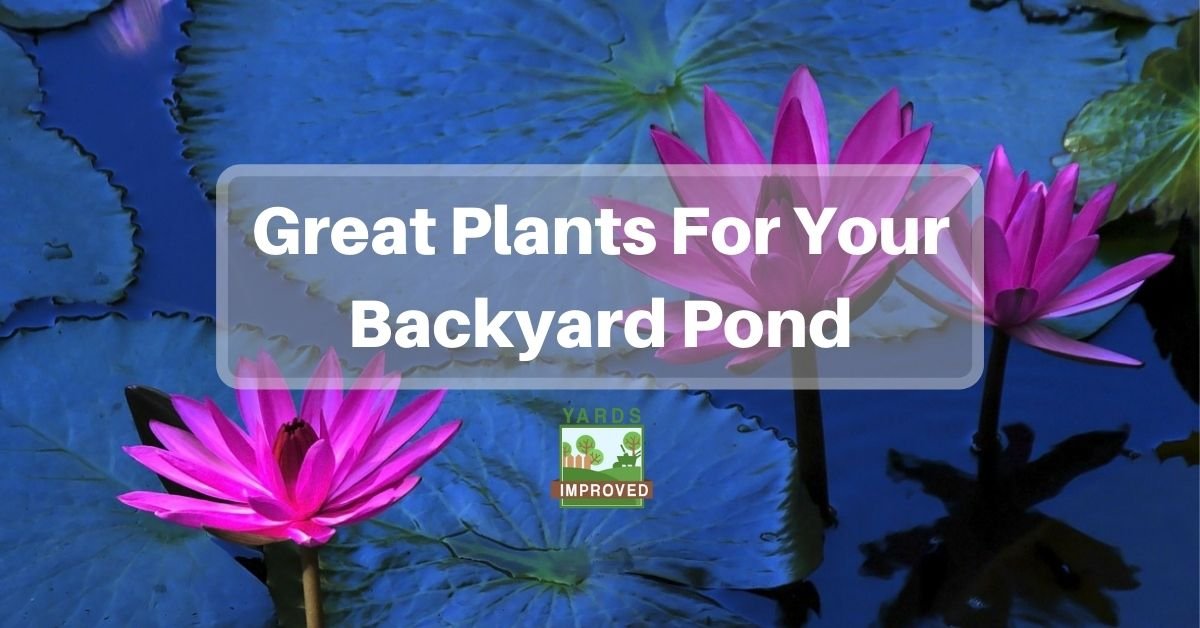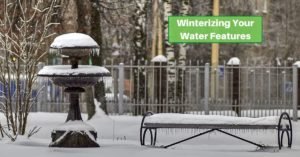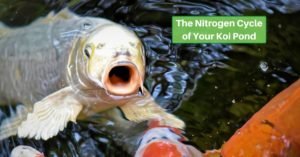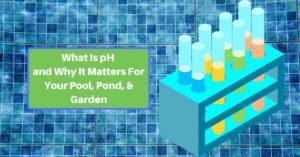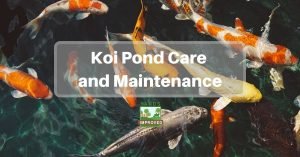A backyard pond can be incredibly relaxing. But having a pond is more than just filling a hole with water. It’s about creating an entire micro-environment. It can look great but also become a home to all types of welcome creatures that add character.
But plant life is another important part of pond life. Not only do plants add beauty, but they are also a crucial part of any ecosystem. They can help keep the pond clean, regulate the water temperature, and attract friendly insects, amphibians and other critters that will help complete the environment.
Some Things To Keep In Mind When Choosing Pond Plants
Of course, you have to carefully select the plants you add to your pond. Not every plant fits in every environment. Some might not work well with each other. You’ll also have to factor in things like how fast and how big they grow. If you have fish in your pond, plants can also be an important part of your filtration system.
Of course, it’s also important to talk about types of pond plants. Plants that are associated with aquatic features can actually fall into several categories based on their root systems.
Taking Root
Where your plants take root and draw their nutrients from can vary. Marginal, or bog, plants root in soil that’s generally underwater, but the majority of the plant is above. Submerged plants have roots in soil but are, as their name says, mostly or completely underwater. Finally, a last type consists of floating plants – the roots don’t need to anchor themselves in soil since they can draw nutrients right from the water. Choosing from all three groups increases both the health and beauty of your pond.
Planting According To Your Climate
Where you live and the climate you experience also have a huge effect on the plants you can choose. An area with extreme summer or winter temperatures is going to have to look at different plants than one that is milder year-round.
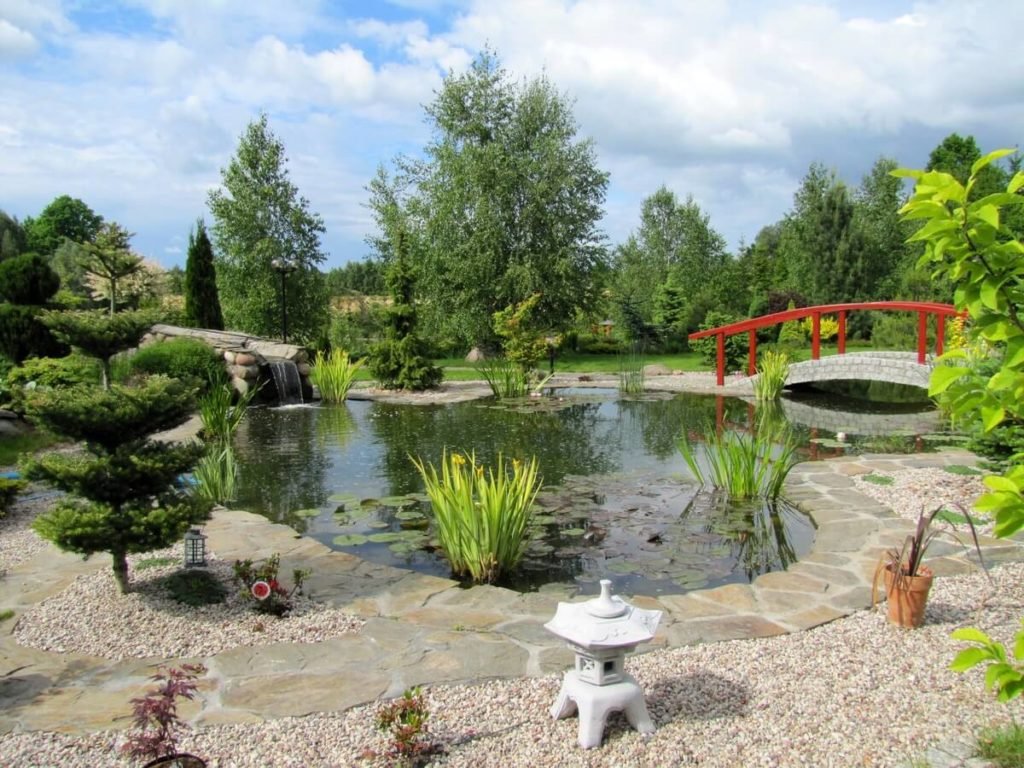
Since there are so many climatic zones, it would be beyond the scope of this article to go into detail here. However, the United States Department of Agriculture has an interactive zone map on their website which can get you started in identifying your own zone. Other countries may offer similar tools to better understand your local conditions.
Plants That Work Well Together
For the most part, keeping a variety of plants is not a problem. There are some simple considerations to remember, though.
The most important is to keep a variety, especially according to the root type. This will help avoid overcrowding in any particular area. By having some of each type, they will mostly stay out of each other’s way.
Another crucial point is to choose plants that are compatible with your region. This is not only based on climate, but on the types of plants that would occur naturally in the area. Introducing non-native species can lead to devastating consequences. Birds and the wind will spread seeds, and plants that are not local may end up competing with and crowding out the native types. So it’s important to choose plants that are typical to your region.
Supporting Clean Water
We know how important plants and trees are on land for creating clean air. In the same way, your pond plants can help filter the water in your pond, keeping it clean and helping convert harmful chemicals to more benign ones. This is especially true if you have koi or other fish. Plants play an important role in the nitrogen cycle by removing nitrates. This helps make the water healthier and also limits algae growth since the algae will have less to feed on.
Some Great Plants For Your Pond
Now that we know more about the role plants play and what to look for, we can get more into specific examples of what works well in a backyard garden. Again, not all of these may be suitable for your particular climate, but most are quite versatile. We’ll try to keep it varied as well with a few examples from each of the types we’ve mentioned.
Calla Lilies (Zantedeschia Aethiopica)
This is a case where the name is deceiving because calla lilies aren’t true lilies. In fact, only the white ones are true calla lilies, while the colored ones are hybrids.
White calla lilies can be submerged completely, but the colored ones should only have the root bulb underwater. But either can also grow out of the water and will do well.
This plant is relatively hardy and easy to maintain so you should be able to enjoy it for a long time. And unlike many other aquatic plants, it adds some extra color, whether through the white flowers or the varied colors of the hybrids.
While in most places the plant has adapted well and hasn’t become intrusive, in Western Australia it is considered a pest. However, that’s the only place that we know of that it’s considered a problem.
Corkscrew Rush (Juncus effusus)
The corkscrew rush isn’t blessed with a beautiful flower, but it does bring a lot of character anyway. Another bog plant, this one is notable for its totally untamed look, with twisting leaves going in every direction at once.

Photo by David J. Stang. Used under CC 4.0 license
There are various cultivars of corkscrew rush available and they offer a variety of maximum heights, so be sure to choose carefully based on what you’re looking for. You don’t want them to totally overshadow everything else! The short types max out around 8 inches while the largest can reach 3 feet!
Horsetail Rush (Equisetum hyemale)
Horsetail rush isn’t in the same genus as corkscrew rush, and its appearance couldn’t be more different, either. This marsh plant grows perfectly straight. It actually looks a bit like young bamboo.
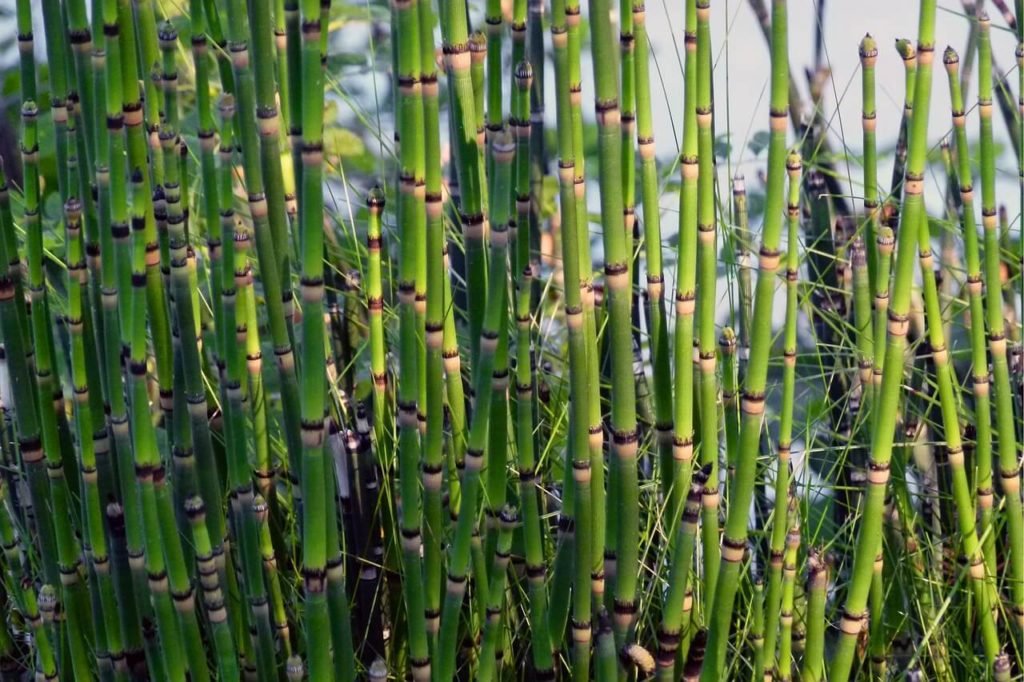
This is a plant that can quickly spread so you might prefer to keep it in pots rather than planted in soil. The pots, of course, can be submerged up to the lower part of the plant itself. The plant spreads by rhizomes rather than seeds, meaning that it’s the roots that will lead to more plants.
This plant stays green year round. In harsher winters, though, it may lose some of its color temporarily. It can grow very tall – from 2 all the way up to 6 feet so this will make a great backdrop behind your pond.
Parrot’s Feather (Myriophyllum Aquaticum)
A submerged plant, parrot’s feather can actually reach a foot or so above water as well. It can grow quite rapidly and spreads through rhizomes, so you have to keep a close eye on it so that it doesn’t overwhelm your pond.
Feather-like leaves grow along the stem, and it produces a small, pink flower as well, adding to its beauty.
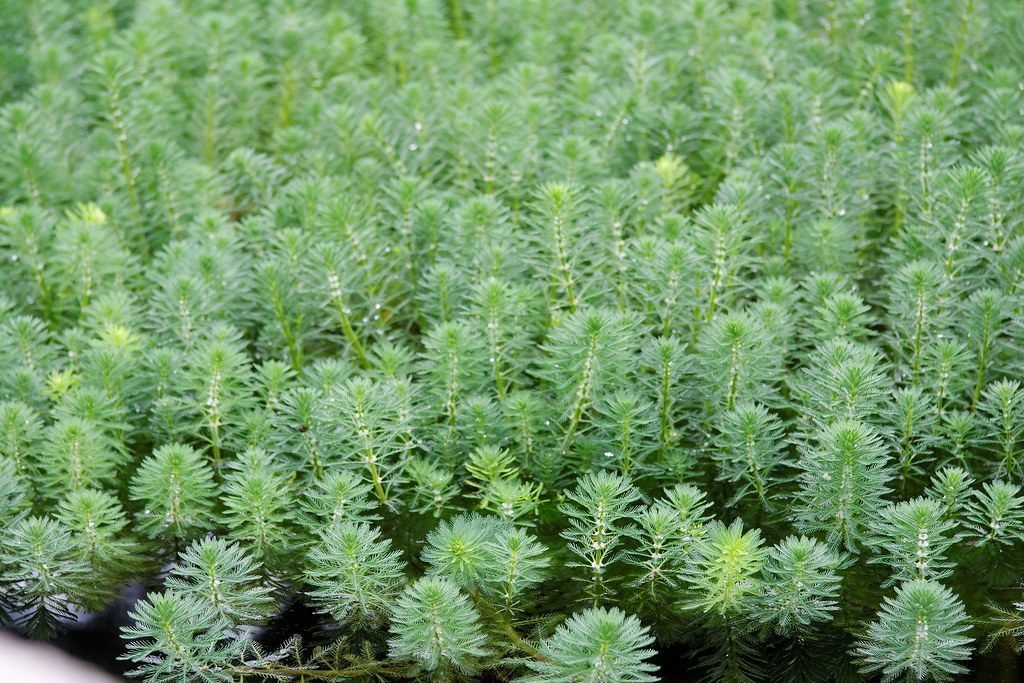
Yes – it does flower, and that usually meanings it would produce seeds. However, there are no male plants in North America. But it can spread by splitting the rhizome – which can be good when done in your own aquarium or pond, but please don’t introduce it where it doesn’t belong!
Water Thyme (Elodea canadensis)
Water thyme is native to North America and is a great submerged plant that provides superb oxygenation for water.
The leaves can be over a half-inch long. The plant roots in the mud and then may grow more roots along the stem. These may grow into the soil or may remain suspended in the water.

It produces a small, white, three-petaled flower. However, it generally reproduces based on cuttings. It’s a perennial, so in a pond, it will return year after year. It also makes a great aquarium plant.
Since it grows so quickly, it is important to keep an eye on it and trim it back as needed.
Arrowhead (Sagittaria subulata)
Arrowhead, also known as grassy arrowhead, is a grasslike plant that can live completely submerged or protruding from the pond’s surface. It does best in shallow waters and can reach heights of over three feet.
This grass grows best in temperatures between 59 F and 85 F. Similar to crabgrass, it grows with the leaves spreading out from a central root clump.

It’s native to New England but has spread to other parts of North America, and in some places is considered invasive. But proper care and guarding against spreading it in the wild will help protect your local area.
Hornwort (genus Ceratophyllum)
The Ceratophyllum genus offers several species of floating plants that are popular for aquariums as well as ponds.
These are rootless plants that have leaves growing at nodes along the stem. That stem can reach 1 – 3 meters in length.

Since they float just under the surface, this can be a great plant for sheltering fish fry. It also produces robust amounts of oxygen. And in addition to process nitrates, they also release a chemical that suppresses algae growth.
Of course, since it’s a submerged planted, it won’t survive outside of water.
With all that going for it, it’s definitely a great addition to your pond!
Water Hyacinth (Eichhornia crassipes)
Like its namesake, this aquatic plant has a beautiful flower that grows on a long, upright stem. While it’s invasive in many areas outside its native Amazon area, if handled correctly it can be a great addition to your garden.
Water hyacinth consumes a lot of nitrates and therefore helps control algae. As a floating plant, it also helps provide shade, regulating the water temperature.

This is known as one of the fastest-growing pond plants, so it’s important to keep an eye on it. It’s good to have partial, but never full, coverage of your pond. About 50% is a good number.
The plant reproduces through runners off the roots.
Water Lettuce (genus Pistia)
Pistia goes by several common names, including water lettuce, Nile cabbage, water cabbage, and shellflower.
While the leaves in one fashion do have the appearance of a partly-opened head of lettuce or cabbage, they’re actually more in the form of a rosette. They’re thick and hardy.
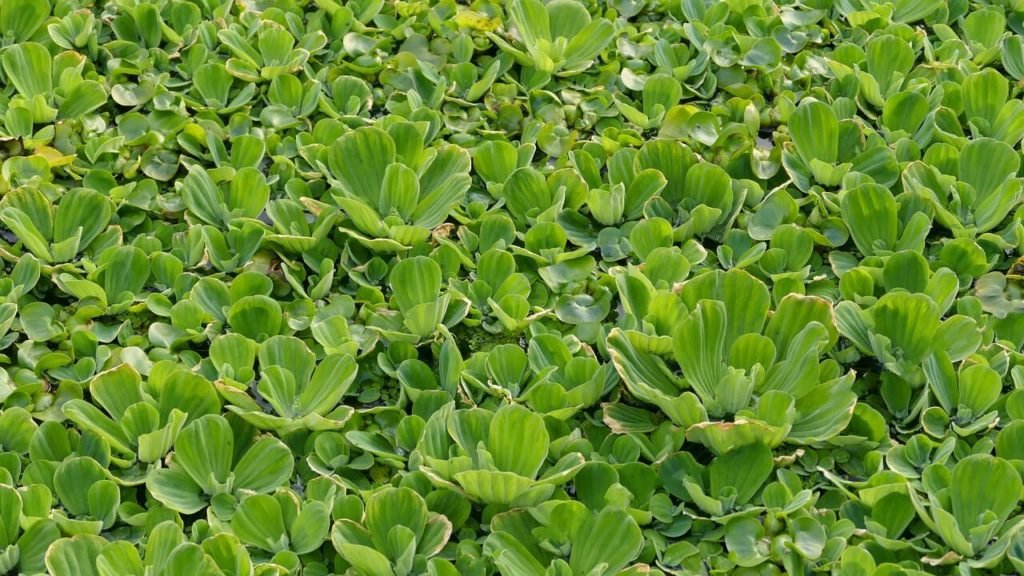
This, like many of the plants here, producing extremely rapidly, so you have to be careful to remove whatever overgrows its bounds. Otherwise, it can block the surface and limit the exchange of gases.
Water Lily (genus Nymphaeaceae)
This family of plants contains five genus and multiple species in each. It’s included here because of our romantic association of it with pond life, especially as a seat for frogs. Most types can also produce a beautiful flower. It’s not the same genus as the lotus, although at one time they were considered to be more closely related.
Water lilies do actually have roots in the soil at the bottom of the water and large leaves that reach the surface. The flowers grow from above the leaves.
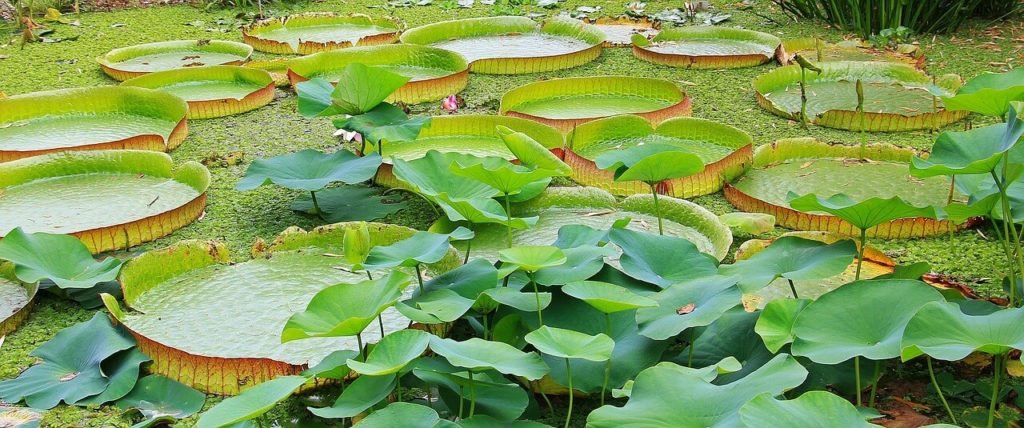
There are no surface leaves in winter, so it’s good to clean up any stray material during this time. In spring, you’ll see air bubbles coming up as new leaves begin rising to the surface and release gases that were stored in the roots and stem.
These can become invasive and do go quickly, although not quite as quickly as some others mentioned here.
While they aren’t fantastic at removing nitrates or introducing oxygen, their large surface leaves contribute a great deal to keep the water from warming too much.
Conclusion
Adding plants to your backyard pond really helps make it complete. There are a huge variety of plants of different sizes, types, and colors that will make great complements to the pond. They’ll help attract creatures of all types as well as keeping the water temperature regulated and the water clean.

